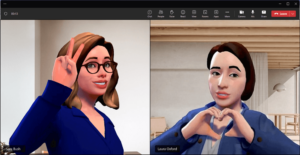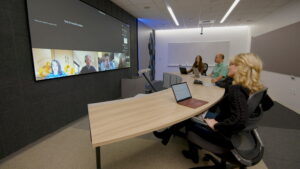 We all know we’re not going back to the way we worked before the COVID-19 pandemic. Flexible work is here to stay. We’ve learned a lot over the past few years, but really, we’re still at the very start of this journey. How do we find new ways to engage with each other and stay connected? What are the innovations that will let us share experiences, together, even if we’re halfway around the world?
We all know we’re not going back to the way we worked before the COVID-19 pandemic. Flexible work is here to stay. We’ve learned a lot over the past few years, but really, we’re still at the very start of this journey. How do we find new ways to engage with each other and stay connected? What are the innovations that will let us share experiences, together, even if we’re halfway around the world?
Microsoft Mesh addresses those questions head-on, enabling shared experiences from anywhere through mixed reality applications. This truly has the potential to revolutionize the hybrid workplace—and the first step in that revolution? Avatars.
An avatar is a digital representation of yourself. You may have used avatars before for things like gaming profiles or social media, but in a business setting? That’s brand new for all of us.
As members of the Microsoft Digital Employee Experience organization, we’re responsible for the technology experiences of customer zero: people working at Microsoft. We knew people would have many questions about avatars. How do they affect connections between coworkers? How do they impact meeting effectiveness and outcomes? Can an avatar ever truly be seen as “professional”?
Everything we do at Microsoft is backed by data, feedback, and research. To tackle these questions, that’s where we had to start.
[Read our blog post about how Avatars for Microsoft Teams is rolling out to general availability in phases starting this week. Learn how you can get more out of your meetings with our Microsoft Teams Meeting guide. Explore how we’re making Microsoft Teams Premium better for customers. Discover how we’re transforming Microsoft with Microsoft Teams.]
Doing the research
It’s important that the work we do supports the creation of a “responsible metaverse,” an inclusive space that’s designed with people’s wellbeing in mind. With that in mind, we engaged with stakeholders and partners to support research and development on diversity, inclusion, and accessibility. We worked with Microsoft researchers, Microsoft Mesh developers and product engineers, and partners both inside and outside of Microsoft. Together, we spent months gathering survey data and user feedback.
These surveys covered a lot of ground, including:
- Inclusive options for creating an avatar
- Overall experience with avatar movement
- Avatars’ responses to audio cues
- Variety in customization and representation
After poring through literally thousands of pieces of feedback, one fact became crystal clear: personalization is king. People want to be able to represent themselves in accordance with their preferences, in detail.
We also found a lot of diversity in how people respond to avatars. Some people find that avatars offer a new level of inclusivity and comfort; others found them distracting or odd. Both reactions are valid, and we wanted to make sure people had guidance for navigating these new experiences.

Taking business etiquette to virtual spaces
As we sifted through all this research, we realized that—after the initial question of, “How do I customize my avatar?”—the second question on people’s minds was, “How should I use avatars?” This summarizes infinite questions about appropriateness. Are avatars useful in all meetings? When is it okay make an avatar dance, and when is it not? This is a whole new world of business etiquette, something no one had experienced before.
In the past, business etiquette and company culture has been learned in person, often picked up by watching others interact and interpreting subtle queues like body language. Clearly, we couldn’t do that here. We needed avatar etiquette. So, armed with our research and key findings, we created guidance for Microsoft employees that we can use as we entered this new world together.
Avatar etiquette
There are no hard and fast rules about when to use an avatar. Like so many things at work, whether an avatar is appropriate or not depends on context.
Understand how avatars currently work
Today’s avatar movement is based solely on audio and any avatar reaction you may choose. Your avatar’s mouth movement is driven by the sound of your voice, and it can’t mimic your body’s movements.
However, it does move a bit on its own. This could come across as insensitive or inappropriate, depending on the context.
As avatar technology evolves, our best practices and etiquette will evolve too. For now, here are the questions we ask ourselves when deciding whether to use an avatar or not.
What kind of meeting is it? What’s its intent?
Strategic, tactical, social—the meeting type influences if an avatar is appropriate. Think about the intent and hoped-for outcomes.
In general, if you would otherwise have your camera off, it’s great to use an avatar instead. Here are some examples:
- A weekly sync with your immediate team
- A hybrid social event for your organization
- An ideation session
- A lunch-and-learn session where you may be eating
There are some meetings where we recommend not using an avatar:
- A one-on-one meeting—unless, of course, you’ve discussed it and would both like to use them.
- Performance reviews (but you probably knew that, right?).
- If you’re involved in a sensitive conversation where body language and facial expression help with engagement. Using your video is best for that.
Will you be presenting?
Whether or not an avatar is appropriate while presenting depends on your audience and presentation content. Who are you presenting to? What is your content and desired outcome?
For some presentations, you probably won’t want to use an avatar (like a proposal to leadership). But for others (like a learning session), it may actually add to your presentation! Consider your audience, content, and desired outcome. This will help you decide. Avatars can be a great ice breaker!
When in doubt, ask!
Avatars are new for all of us, so it’s important to bring a growth mindset when using them.
- Have a conversation with your coworkers about how your team feels about avatars. Are there specific guidelines you want to set for your team?
- Are there times avatars might feel like a distraction?
- If you’re a presenter in someone else’s meeting, ask them if they have a preference for how you show up.
- What makes you feel the most comfortable? Your preferences matter, too!
- Remember: it can take a while for people to grow comfortable with new technology, especially when it feels personal. If we all treat each other with mutual respect—including our “avatar selves”—we’ll go a long way toward making every meeting inclusive and effective.
When is it okay to bust a move?
Fist bumps, the wave, peace out—there are a lot of super fun avatar reactions to play with. They add a lot of energy and enthusiasm to a meeting, but sometimes, it’s best to stay still.
Think about it this way: if you were in a physical room with the other meeting attendees, would you do that same physical reaction? If the answer is no, then wait until the moment’s right.
And please do remember, an avatar’s movement does not currently mirror the movement of the person behind the avatar. So, if you need to step away during a meeting, remember to tell people. They can’t tell from your avatar!

Representation matters
One key thing to keep in mind: an avatar represents the way that person wants to be represented. This may sometimes mean your avatar doesn’t look the way others expect. That’s okay! The goal is for you to feel accurately represented and fully included. You’re the only one who decides what that means to you.
That said, sometimes we do want an outside opinion. If you feel like you’re having a tough time getting your avatar right, ask a trusted teammate for feedback. It can be fun to hop on a call and do it together.
Please do be aware of and avoid cultural appropriation and remember our commitment to being diverse and inclusive. If you’re not finding the right options for customizing your avatar, let us know by providing feedback through the Teams desktop app. The avatar team is eagerly working to make improvements that allow everyone to be expressive, engaged, represented, and heard.

It’s going to take all of us to create a responsible metaverse. Like all forms of etiquette, our guidance will evolve over time to make sure it meets the needs of a diverse global workforce. We’ll continue to iterate and present new features, customization options, and overall experiences with avatars that support a new and connected way to show up in our world of flexible work.
Read our blog post about how Avatars for Microsoft Teams is rolling out to general availability in phases starting this week, and the latest Mesh product and customer news. Learn how to set up avatars for your organization, and how to join a meeting with a avatar. For more information, visit our Microsoft Mesh website.

- Read our blog post about how Avatars for Microsoft Teams is rolling out to general availability in phases starting this week.
- Learn how you can get more out of your meetings with our Microsoft Teams Meeting guide.
- Explore how we’re making Microsoft Teams Premium better for customers.
- Discover how we’re transforming Microsoft with Microsoft Teams.




